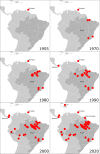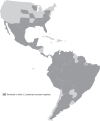Baseline mapping of Oropouche virology, epidemiology, therapeutics, and vaccine research and development
- PMID: 35301331
- PMCID: PMC8931169
- DOI: 10.1038/s41541-022-00456-2
Baseline mapping of Oropouche virology, epidemiology, therapeutics, and vaccine research and development
Abstract
Oropouche virus (OROV) is an arthropod-borne orthobunyavirus found in South America and causes Oropouche fever, a febrile infection similar to dengue. It is the second most prevalent arthropod-borne viral disease in South America after dengue. Over 500,000 cases have been diagnosed since the virus was first discovered in 1955; however, this is likely a significant underestimate given the limited availability of diagnostics. No fatalities have been reported to date, however, up to 60% of cases have a recurrent phase of disease within one month of recovery from the primary disease course. The main arthropod vector is the biting midge Culicoides paraensis, which has a geographic range as far north as the United States and demonstrates the potential for OROV to geographically expand. The transmission cycle is incompletely understood and vertebrate hosts include both non-human primates and birds further supporting the potential ability of the virus to spread. A number of candidate antivirals have been evaluated against OROV in vitro but none showed antiviral activity. Surprisingly, there is only one report in the literature on candidate vaccines. We suggest that OROV is an undervalued pathogen much like chikungunya, Schmallenberg, and Zika viruses were before they emerged. Overall, OROV is an important emerging disease that has been under-investigated and has the potential to cause large epidemics in the future. Further research, in particular candidate vaccines, is needed for this important pathogen.
© 2022. The Author(s).
Conflict of interest statement
A.D.T.B is the editor-in-Chief of
Figures


References
Publication types
Grants and funding
LinkOut - more resources
Full Text Sources
Molecular Biology Databases

